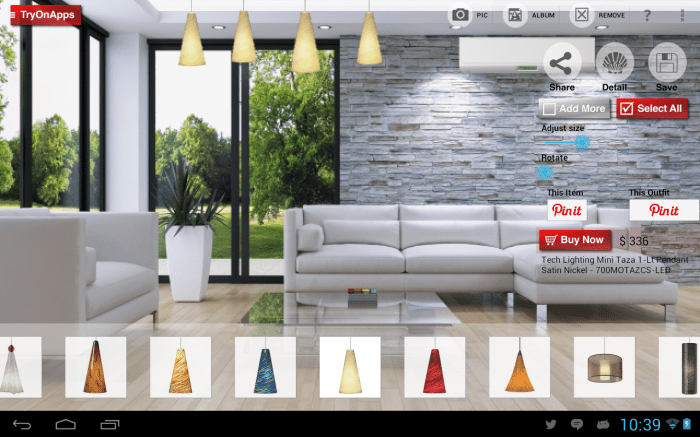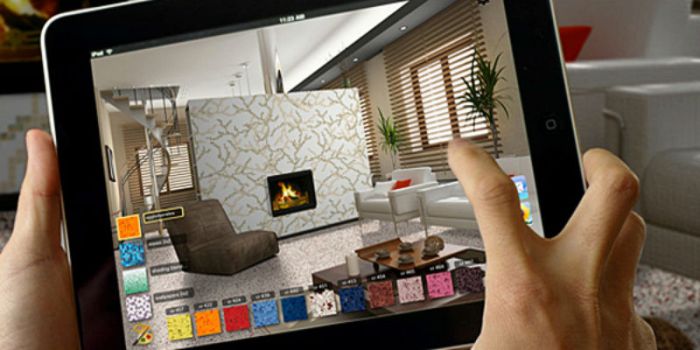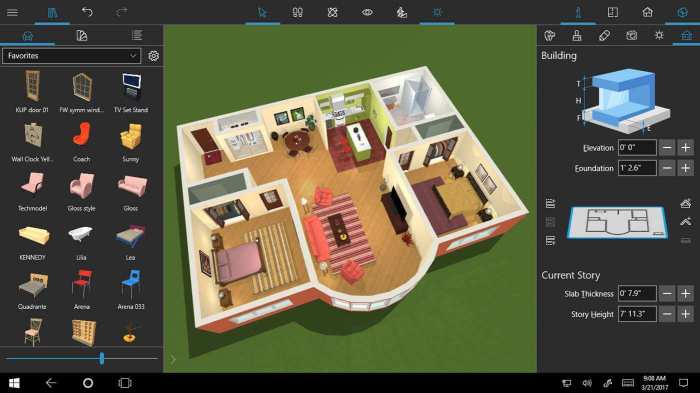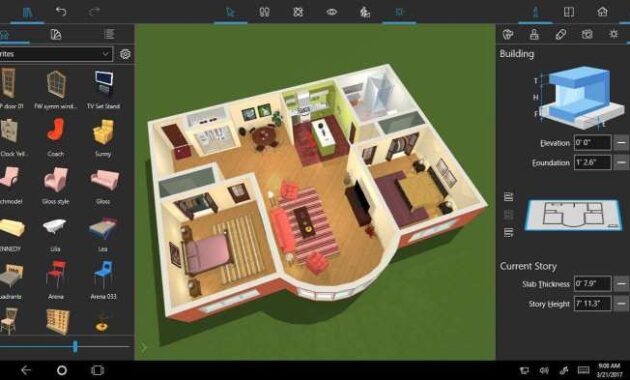App for house interior design has taken center stage, revolutionizing how we approach home decor. These digital tools empower us to explore limitless possibilities, transforming our vision into reality with a few taps on our screens.
From planning the perfect layout to visualizing furniture placement, color palettes, and even incorporating augmented reality, these apps offer a wealth of features to guide us through every step of the design process. Whether you’re a seasoned DIY enthusiast or a design novice, there’s an app out there to cater to your needs and elevate your home design journey.
Benefits of Using Home Interior Design Apps
Interior design apps have revolutionized the way people approach home décor. They offer a range of tools and features that empower users to create their dream spaces, from conceptualizing layouts to selecting furniture and colors. These apps streamline the design process, making it more accessible and enjoyable for everyone.
Cost-Effectiveness
Interior design apps can significantly reduce the cost of professional design services. Users can experiment with different design ideas and create virtual mockups without incurring the expenses associated with hiring a professional. These apps often provide free or affordable access to a vast library of furniture, décor, and color palettes, allowing users to explore various options without spending a fortune.
Time-Saving
Traditional home design often involves time-consuming tasks like visiting furniture stores, researching products, and physically rearranging furniture. Interior design apps streamline these processes by providing a centralized platform for browsing, planning, and visualizing. Users can quickly explore different design concepts, compare products, and create layouts within the app, saving valuable time and effort.
Increased Creativity
Interior design apps encourage creativity by offering a wide range of tools and features. Users can experiment with different color palettes, furniture arrangements, and décor styles, unleashing their imagination and discovering new design possibilities. The apps often include features like virtual reality (VR) or augmented reality (AR) that allow users to visualize their design choices in a real-world context, further stimulating their creativity.
Improved Visualization, App for house interior design
One of the biggest advantages of using interior design apps is the ability to visualize design concepts in 3D. These apps create realistic renderings of rooms and spaces, allowing users to see how different design choices will look in their homes before committing to any purchases.
This improved visualization helps users make informed decisions and avoid costly mistakes.
Popular Home Interior Design Apps

Home interior design apps have gained immense popularity, offering a wide range of features to help users visualize and create their dream spaces. These apps provide a user-friendly interface, making the design process accessible to everyone, regardless of their design expertise.
Apps for house interior design have become increasingly popular, offering users a convenient way to visualize their dream home. These apps allow you to experiment with different color palettes, furniture arrangements, and even lighting, helping you create a space that truly reflects your style.
For those seeking inspiration and guidance, exploring resources like a house interior design website can be invaluable. Whether you’re a seasoned DIYer or a design novice, these apps provide a user-friendly platform to explore your design vision and bring it to life.
Popular Home Interior Design Apps
Here’s a table highlighting some of the most popular home interior design apps, along with their key features and pricing:
| App Name | Platform(s) | Key Features | Pricing |
|---|---|---|---|
| Houzz | iOS, Android, Web | – Vast library of home design inspiration, including photos, products, and professionals.- Room planning tools to create floor plans and visualize furniture placement.- Idea books to save and organize design ideas.- Connect with professionals for consultations and project management. | Free (with in-app purchases for premium features) |
| RoomSketcher | iOS, Android, Web | – Easy-to-use floor plan creation tools.- 3D visualization to see designs come to life.- Furniture and decor library with various styles and brands.- Collaboration features for sharing projects with others. | Free (with subscription options for advanced features) |
| IKEA Place | iOS, Android | – Augmented reality (AR) to place IKEA furniture in your real-life space.- Virtual shopping experience to purchase IKEA products directly within the app.- Access to IKEA’s vast furniture catalog.- 3D visualization of furniture in your space. | Free |
| Planner 5D | iOS, Android, Web | – Comprehensive floor plan creation tools with detailed customization options.- 3D visualization with realistic lighting and textures.- Extensive furniture and decor library.- Export projects in various formats for sharing or printing. | Free (with in-app purchases for premium features) |
| Home Design 3D | iOS, Android | – Intuitive interface for designing floor plans and 3D spaces.- Wide range of furniture, materials, and decor options.- Realistic rendering with lighting and shadows.- Export projects in various formats for sharing or printing. | Free (with in-app purchases for premium features) |
Tips for Using Home Interior Design Apps Effectively

Home interior design apps can be a valuable tool for transforming your living spaces, but getting the most out of them requires a strategic approach. By following these tips, you can harness the full potential of these apps and create a home that truly reflects your style and preferences.
Starting with a Clear Vision
Before diving into the world of virtual design, it’s crucial to have a clear understanding of your desired outcome. This involves identifying your personal style, considering your budget, and pinpointing the specific areas you want to renovate.
- Define Your Style:Explore different interior design styles, such as modern, minimalist, farmhouse, or eclectic, and identify the one that resonates with you. This will help you narrow down your choices and create a cohesive look.
- Set a Budget:Establish a realistic budget for your project. This will guide your choices and prevent overspending. Consider the cost of furniture, materials, and labor.
- Focus on Specific Areas:Instead of trying to redesign your entire home at once, start with a single room or area. This allows you to experiment with different features and build confidence before tackling larger projects.
Experimenting with Different Features
Most home design apps offer a wide range of features, including furniture placement, color palettes, and material selection. Take advantage of these features to explore different possibilities and discover what works best for your space.
- Try Out Various Layouts:Experiment with different furniture arrangements to optimize space and create a functional and visually appealing layout.
- Play with Colors and Textures:Use the color palette feature to experiment with different shades and tones. Try different textures and patterns to add depth and visual interest.
- Explore Different Materials:Home design apps often allow you to visualize various materials, such as wood, tile, or stone. This helps you see how different options would look in your space.
Seeking Inspiration from Online Resources
The internet is a treasure trove of interior design inspiration. Explore online platforms, blogs, and social media for ideas that spark your creativity.
App-based interior design tools can help you visualize and plan your dream home, even if you’re looking for inspiration from a specific era. If you’re drawn to the elegance and charm of the 1930s, consider exploring 1930s semi detached house interior design for ideas.
These apps allow you to experiment with different layouts, color palettes, and furniture styles, ensuring your final design reflects your personal taste and the era you admire.
- Browse Interior Design Websites:Websites like Houzz, Pinterest, and Architectural Digest showcase a wide range of design projects, from contemporary to traditional, offering inspiration for different styles and spaces.
- Follow Interior Designers on Social Media:Instagram and Pinterest are great platforms to follow interior designers and see their latest projects and design trends.
- Explore Design Blogs:Numerous blogs dedicated to interior design provide insightful articles, tips, and design ideas, covering a wide range of topics from color palettes to furniture selection.
Utilizing the Community Features
Many home design apps have community features that allow you to connect with other users, share your designs, and get feedback.
- Share Your Designs and Get Feedback:Use the community features to share your designs with other users and get constructive feedback. This can help you refine your ideas and discover new perspectives.
- Join Design Challenges:Some apps host design challenges, providing an opportunity to test your skills and get inspired by other users’ creations.
- Connect with Professionals:Some apps offer the option to connect with professional interior designers for personalized advice and guidance.
Design Trends and Inspirations
Home interior design trends are constantly evolving, reflecting changes in lifestyle, technology, and cultural preferences. Understanding these trends can help you create a stylish and functional space that reflects your personal taste. This section explores some of the most popular and enduring design styles, providing inspiration and practical tips for incorporating them into your home.
Minimalist Design
Minimalism emphasizes simplicity, functionality, and clean lines. It prioritizes essential furniture and decor, often featuring neutral colors, natural materials, and a focus on negative space. Minimalist design promotes a sense of calm and order, making it ideal for smaller spaces or those seeking a clutter-free environment.
“Less is more.”
Ludwig Mies van der Rohe
- Color Palette:Neutral colors like white, gray, black, and beige are dominant, with occasional pops of color for accent.
- Materials:Natural materials like wood, stone, and leather are favored, along with sleek metal accents.
- Furniture:Simple, functional furniture with clean lines and minimal ornamentation is preferred.
- Lighting:Natural light is maximized, and artificial lighting is used strategically to highlight key areas.
- Decor:Minimalist decor includes carefully curated pieces that add visual interest without overwhelming the space.
Scandinavian Design
Scandinavian design, often referred to as “Scandi,” is characterized by its clean lines, functional furniture, and use of natural materials. It embraces a light and airy aesthetic, often incorporating light wood tones, white walls, and pops of color.Scandinavian design promotes a sense of warmth and comfort, creating a welcoming and inviting atmosphere.
- Color Palette:Light and airy colors like white, gray, and beige are dominant, with accents of natural wood tones and pops of color like blue, green, and yellow.
- Materials:Natural materials like wood, wool, and cotton are favored, along with leather and metal accents.
- Furniture:Functional and comfortable furniture with simple designs and clean lines is preferred.
- Lighting:Natural light is maximized, and artificial lighting is used to create a warm and inviting ambiance.
- Decor:Minimalist decor with a focus on natural elements, such as plants, artwork, and textiles, is common.
The Future of Home Interior Design Apps

The world of home interior design apps is evolving rapidly, driven by advancements in technology, the increasing popularity of DIY home renovations, and the growing demand for personalized design solutions. As these apps become more sophisticated, they are poised to transform the way we design and decorate our homes.
Integration of Artificial Intelligence (AI)
AI will play a pivotal role in shaping the future of home interior design apps. AI algorithms can analyze user preferences, analyze images, and generate personalized design suggestions. This can lead to a more intuitive and efficient design process, where users can receive tailored recommendations based on their individual needs and tastes.
- AI-powered virtual assistants:These assistants can help users with tasks such as selecting furniture, colors, and materials, and even suggest alternative design solutions based on user feedback. For example, an AI-powered assistant could analyze a user’s uploaded photo of their living room and suggest furniture arrangements, color palettes, and lighting options that complement the existing decor.
- Augmented reality (AR) and virtual reality (VR):These technologies will allow users to experience their designs in a realistic 3D environment. Users can virtually “walk through” their redesigned spaces, experiment with different furniture arrangements, and even visualize how different lighting schemes affect the overall ambiance. For example, an AR app could allow users to overlay virtual furniture onto a live view of their room, giving them a realistic preview of how the furniture would look in their space.
App for house interior design can help you visualize your dream home, and if you’re working with a 2 bedroom layout, there are plenty of great resources available. Check out this article on 2 bedroom house interior design for some inspiration.
Once you’ve got a good idea of what you want, you can use the app to experiment with different color palettes, furniture arrangements, and even lighting.
- Personalized design recommendations:AI algorithms can analyze user data, such as browsing history, saved designs, and social media activity, to generate personalized design recommendations that align with their preferences. This can help users discover new styles and ideas they may not have considered otherwise.
For example, an app could suggest furniture and decor based on the user’s favorite interior design styles or the colors they frequently use in their social media posts.
Conclusion: App For House Interior Design
Home interior design apps have revolutionized the way we approach our home design projects, offering a wealth of benefits and possibilities. These apps empower us to visualize our dream spaces, experiment with different styles and layouts, and make informed decisions before committing to any real-world changes.
The Power of Visualization and Experimentation
Home interior design apps provide an interactive platform for visualizing and experimenting with design ideas. Users can effortlessly rearrange furniture, change wall colors, and even try out different lighting scenarios, all within the digital realm. This ability to visualize and experiment helps users gain a clear understanding of how their design choices will translate into reality, reducing the risk of costly mistakes and ensuring greater satisfaction with the final outcome.
The Importance of User-Friendly Interfaces and Accessibility
The user-friendliness of home interior design apps is paramount. They are designed to be intuitive and accessible to users of all skill levels, regardless of their prior experience with design software. These apps often incorporate features like drag-and-drop functionality, pre-designed templates, and guided tutorials, making the design process both enjoyable and manageable.
The Future of Home Interior Design Apps
As technology continues to evolve, we can expect home interior design apps to become even more sophisticated and integrated into our lives. Emerging technologies like augmented reality (AR) and virtual reality (VR) will allow for even more immersive and realistic visualizations, blurring the lines between the digital and physical worlds.
Moreover, the integration of AI-powered features will provide personalized design recommendations and automate certain design tasks, making the home design process even more efficient and tailored to individual preferences.
Final Wrap-Up
The rise of app for house interior design has democratized home design, making it accessible and engaging for everyone. These apps provide a platform for creativity, empowering us to explore different styles, experiment with layouts, and ultimately, design a space that truly reflects our personality and taste.
As technology continues to evolve, we can expect even more innovative features and personalized experiences, making the dream of creating a beautiful and functional home more attainable than ever before.
Clarifying Questions
What are the most popular home interior design apps?
Some of the most popular apps include Houzz, RoomSketcher, IKEA Place, Planner 5D, and Home Design 3D. Each offers unique features and caters to different needs and experience levels.
Are home interior design apps free?
Many apps offer free versions with limited features. Premium versions with expanded functionality often require a subscription or one-time purchase.
Can I use home interior design apps on my phone or computer?
Most apps are available on both iOS and Android devices, and some also offer desktop versions.
Do I need design experience to use these apps?
No, these apps are designed to be user-friendly and intuitive, even for beginners. They offer tutorials and guides to help you get started.

